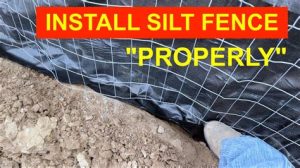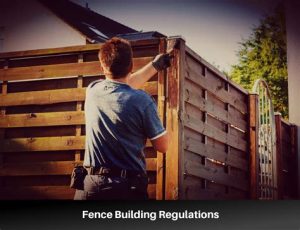Learn how to navigate fence installation permits, from local requirements to application processes, and explore our step-by-step guide for selecting materials and DIY installation.Installing a fence is an excellent way to enhance your property’s aesthetics, ensure privacy, and increase security. However, embarking on this DIY project involves more than just choosing your favorite materials and setting some posts in the ground. Before you grab your tools, it’s crucial to understand the permitting process to ensure your installation complies with local regulations. This blog post will guide you through the essential steps of fence installation—from researching local permit requirements to selecting suitable materials and providing a comprehensive DIY installation guide. Whether you’re a seasoned DIYer or a first-time homeowner, this post will equip you with the knowledge and confidence to transform your outdoor space while adhering to all necessary guidelines. Get ready to roll up your sleeves and create a beautiful fence that enhances your home!
Understanding Fence Installation Permits
When considering a fence installation, one of the most important aspects to address is the need for permits. In many areas, local regulations require homeowners to obtain a permit before construction begins. This article will give you insights into why permits are essential and how to navigate the process.
Obtaining a permit is crucial because it ensures compliance with local zoning laws and building codes. Failing to secure the necessary permits may result in fines, required removal of the fence, or legal action from neighbors. Additionally, permits help to ensure that your fence is built safely and will stand the test of time.
Before starting your fence installation, it’s wise to check with your local government or homeowner’s association. Gather all the necessary information regarding height restrictions, property lines, and any specific regulations that may apply. A simple call or visit to the local office can save you from many headaches down the road.
Whether you’re enhancing your backyard’s privacy or defining your property lines, understanding the importance of fence installation permits is essential for a successful project. Make sure to allocate time and resources for this crucial step before getting started.
Researching Local Permit Requirements
When considering a DIY fence installation, the first step is to research your local permit requirements. Each locality has its own regulations that dictate whether you need a permit for fence construction, and if so, what guidelines you must follow. Understanding these requirements is crucial to avoid any potential fines or the need to remove your newly built fence.
To begin, visit your local government’s website or contact the building department to obtain the latest information on permits related to fence installation. Many cities provide detailed guidelines on their websites, including restrictions on height, material types, and proximity to property lines. Some municipalities may even have online portals to submit permits digitally, making the process more streamlined.
In addition to zoning restrictions, it’s also important to consider other factors such as homeowner association (HOA) rules if you live in a community governed by an HOA. They often have specific stipulations about fence appearance, materials, and placement which must be adhered to before you can begin the installation process.
Completing Permit Application Process
When it comes to fence installation, understanding the permit application process is a crucial step that cannot be overlooked. Every township or municipality has its own guidelines regarding construction permits, including those for fencing. Failing to adhere to these regulations can lead to fines or the requirement to remove your newly installed fence, so it’s essential to be well-prepared.
- Research Local Regulations: Before submitting your application, familiarize yourself with local zoning laws and restrictions. These can vary widely, affecting the height, style, and placement of your fence.
- Gather Required Documents: Most municipalities will require specific documents, including site plans, property surveys, and any other relevant information regarding the proposed installation location.
- Fill Out the Application: Complete the permit application form accurately. Be sure to provide all necessary details including your information, project specifications, and any permits previously acquired.
- Submit Your Application: When your application is ready, submit it to the appropriate local authority. This could be a zoning board, city hall, or local planning department.
- Pay the Necessary Fees: Be prepared to pay any associated fees with the application submission. Keep in mind that these fees can vary depending on your location and the scope of your project.
- Await Approval: After submission, the local authority will review your application. Make sure to follow up if you do not hear back within a reasonable time frame.
Obtaining a permit for your fence installation may seem like an added step, but it protects your investment and ensures compliance with local regulations. Always double-check your findings with your local building department and consider speaking to a professional if you have questions about the permit requirements in your area.
Selecting Suitable DIY Fence Materials
When embarking on a DIY fence installation, one of the most crucial steps is selecting suitable materials. Your choice of fence materials not only affects the overall look but also the durability and maintenance of your fence. Below are some popular materials you may consider, along with their unique characteristics.
| Material | Durability | Cost | Maintenance |
|---|---|---|---|
| Wood | Moderate | $$ | High |
| Vinyl | High | $$$ | Low |
| Chain Link | High | $ | Low |
| Composite | High | $$$ | Moderate |
| Metal | Very High | $$$ | Low |
Wood is a classic choice that provides a natural look and can be customized easily. However, it requires regular maintenance such as staining and sealing to prevent rot and decay. Vinyl is gaining popularity due to its low maintenance and variety of styles and colors, making it an appealing choice for many homeowners.
If you need a cost-effective solution, chain link fences offer practicality and strength, though they may lack privacy unless you add slats or fabric. On the other hand, composite and metal materials are excellent for longevity and can withstand harsh weather conditions, although they often come at a higher initial cost.
When selecting materials, consider your climate, desired aesthetics, and budget. Make sure to also check local regulations and ensure that your chosen material complies with any zoning laws regarding fence installation.
Step-by-Step DIY Fence Installation Guide
Installing a fence may seem like a daunting task, but with the right guidance and tools, it can be a rewarding DIY project. In this guide, we will outline the key steps necessary for a successful fence installation, ensuring that you’re well-prepared to tackle your fencing needs.
Before diving into the installation process, it’s important to gather the right materials. Common fence materials include wood, vinyl, and metal. Each type has its own benefits and aesthetic appeal, so choose one that suits your needs and complements your property.
- Step 1: Determine the fence line – Use stakes and string to outline where the fence will go.
- Step 2: Check local regulations – Ensure you have the necessary permits and abide by any zoning laws.
- Step 3: Gather materials and tools – Get everything you need including posts, panels, nails, and tools like a level and post hole digger.
- Step 4: Set the posts – Dig holes for each post, set them in concrete, and ensure they’re level.
- Step 5: Attach the panels – Secure the fence panels to the posts using the appropriate fasteners.
- Step 6: Finish up – Add any finishing touches like paint or gates, making sure everything is safe and secure.
It’s crucial to measure accurately and maintain consistency throughout the installation process. Don’t rush; take your time to ensure each step is completed correctly.
Frequently Asked Questions
What are the first steps to consider before installing a fence?
Before installing a fence, it’s important to check local regulations and zoning laws, obtain any necessary permits, and determine property lines.
What tools are typically needed for a DIY fence installation?
Common tools needed for a DIY fence installation include a post hole digger, leveling tool, hammer, saw, and measuring tape.
How do I determine the right type of fence for my property?
Consider the purpose of the fence, such as privacy, security, or aesthetics, and choose materials that best suit your needs, climate, and budget.
What are some important safety tips to keep in mind during installation?
Always wear protective gear, ensure you are aware of underground utilities, and work with a partner if handling heavy materials.
How can I ensure my fence is level and straight?
Use a leveling tool regularly as you install posts and check for consistency in measurements to make sure the fence is both level and straight.
What are the typical costs associated with DIY fence installation?
Costs can vary widely based on materials, size, and local prices, but budgeting for materials, tools, and potential permit fees is essential.
Are there any common mistakes to avoid during DIY fence installation?
Common mistakes include neglecting to check property lines, failing to secure necessary permits, and rushing the installation process, which can lead to misaligned fences.




